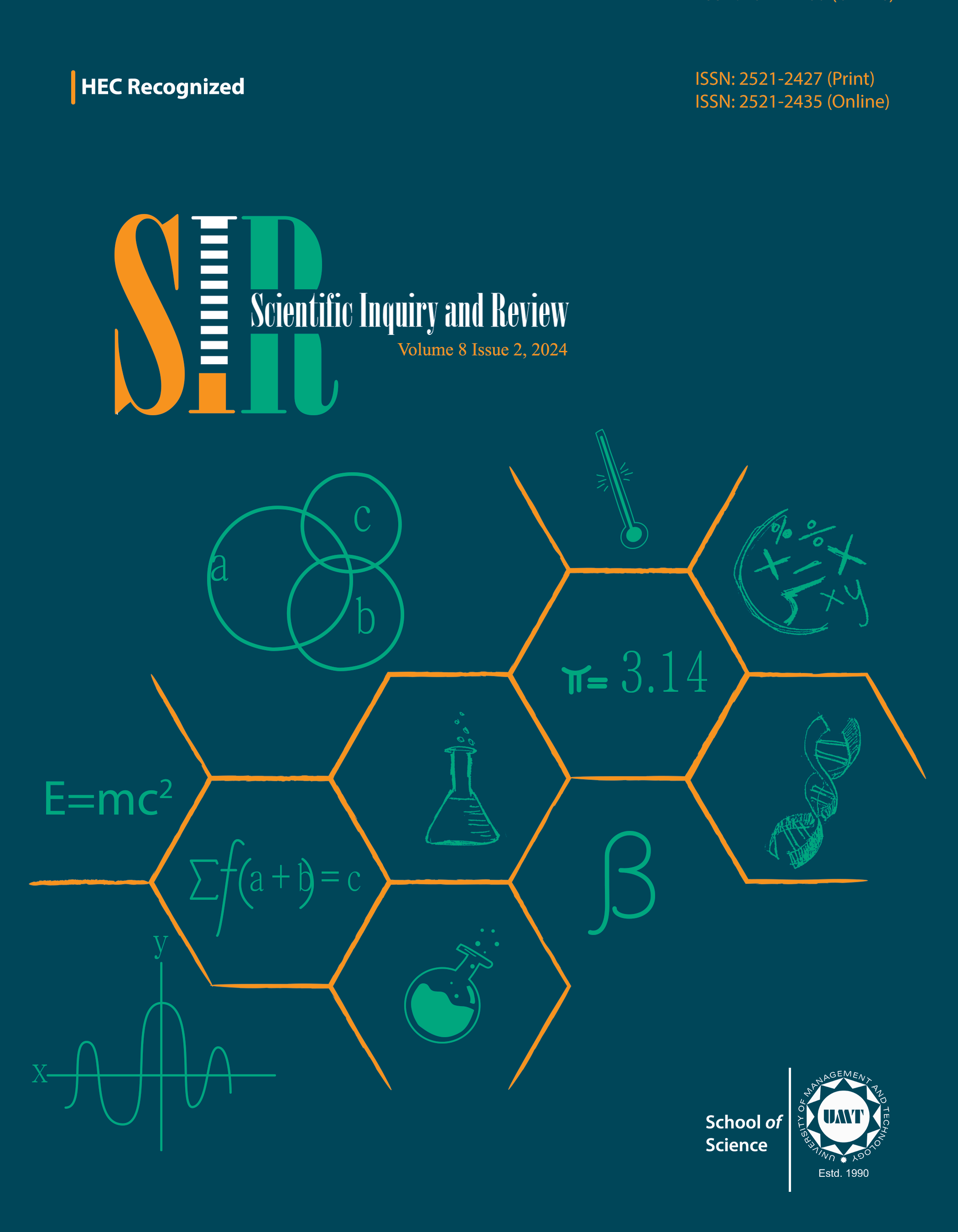Synthesis, Characterization and Biological Activity of Fe(II), Cu(II), and Cd(II) with Schiff Base Ligands (SBLs): Biological Screening of Divalent Metal Chelated Complex
Abstract
 Abstract Views: 0
Abstract Views: 0
This study aimed to develop novel Schiff base ligands (SBLs), namely N1,N2-Bis(4-nitrobenzylidene)benzene-1,2-diamine (1), 4,6-Dimethyl-N-((5-nitrofuran-2-yl)methylene)pyrimidin-2-amine (2) and N1,N2-Bis((5-nitrofuran-2-yl)methylene)benzene-1,2-diamine (3). It also aimed to examine how they coordinate with various bidentate transition metal ions to form metal complexes. The goal was to properly characterize the newly synthesized chemicals and investigate their possible uses in chemical and pharmaceutical industries, with an emphasis on the drug industry. Thin-layer chromatography (TLC) was used to methodically monitor and confirm the synthesis process at each step. The compounds were then put through characterization procedures such as Fourier transform infrared spectroscopy (FTIR), urease inhibition assays, and assessments of antioxidant activity.
Downloads
References
Althobiti HA, Zabin SA. New schiff bases of 2-(quinolin-8-yloxy) acetohydrazide and their Cu (II), and Zn (II) metal complexes: their in vitro antimicrobial potentials and in silico physicochemical and pharmacokinetics properties. Open Chem. 2020;18(1):591–607. https://doi.org/10.1515/chem-2020-0085
Thamer AA, Ahmed NA, Saeed SS, Alhamzi EHL, Albadri AEAE. Synthesis, characterization and anticancer activity of some metal complexes with a new Schiff base ligand. Arab J Chem. 2022;15(2):e103559. https://doi.org/10.1016/j.arabjc.2021.103559
Garima M. Schiff bases and complexes: a review on anti-cancer activity. Anticancer Agents Med Chem. 2020;20(16):1908–1917. https://doi.org/10.2174/1871520620666200507091207
Zhao B, Ni C, Gao R, et al. Recapitulation of SARS-CoV-2 infection and cholangiocyte damage with human liver ductal organoids. Protein Cell. 2020;11(10):771–775. https://doi.org/10.1007/s13238-020-00718-6
Shanthi N, Sarma DD. Electronic structure of electron doped SrTiO3: SrTiO3−δ and Sr1−xLaxTiO3. Phys Rev B. 1998;57(4):2153–2158. https://doi.org/10.1103/PhysRevB.57.2153
Caliskan N, Usta A, Beris F, Baltas N, Celik E. Synthesis, antibacterial and antioxidant activities of some new n-substituted azachalcone, Schiff base and pyrazole derivatives. Lett Org Chem. 2020;17(8):631–638. https://doi.org/10.2174/1570178617666200108111211
Galyna PV, Michail AT, Volodymyr GB, et al. Novel isoniazid derivative as promising antituberculosis agent. Future Microbio. 2020;15(10):869–879. https://doi.org/10.2217/fmb-2019-0085
Patil PS, Kasare SL, Haval NB, et al. Novel isoniazid embedded triazole derivatives: synthesis, antitubercular and antimicrobial activity evaluation. Bioorg Med Chem. 2020;30:e127434. https://doi.org/10.1016/j.bmcl.2020.127434
Pandey AK. Anticonvulsant activity of novel Schiff bases of thiadiazole derivatives. Bangladesh J Pharmacol. 2019;14(3):127–128. https://doi.org/10.3329/bjp.v14i3.41543
Wei D, Li N, Lu G, Yao K. Synthesis, catalytic and biological activity of novel dinuclear copper complex with Schiff base. Sci China Ser B. 2006;49(3):225–229. https://doi.org/10.1007/s11426-006-0225-8
Anu K, Suman B, Sunil K, Neha S, Vipin S. Schiff bases: a versatile pharmacophore. J Catal. 2013;2013(1):e893512. https://doi.org/10.1155/2013/893512
Subasi NT. Overview of schiff bases. In: Akitsu T, ed. Schiff Base in Organic, Inorganic and Physical Chemistry. Intech Open; 2023.
Aslam M, Anis I, Noreen Z, et al. Synthesis, single crystal x-ray and biological study of transition metal complexes of N,N-donor Schiff base ligand: N1,N2-Bis[(4-Methoxyphenyl)Methylidene]-1,2-Ethanediamine. J Nat Appl Sci Pak. 2023;5(1):1222–1232.
Aslam M, Gulzar A, Mehmood R, et al. Synthesis, characterization, biological screening and determination of stability constants of N,N′‑Bis[1‑(4‑chlorophenyl)ethylidene]ethane‑1,2‑diamine. SN Appl Sci. 2021;3:e22. https://doi.org/10.1007/s42452-020-04029-7
Aslam M, Anis I, Noreen Z, Gulzar A, Tahir MH. Synthesis, characterization and biological screening of Ni(II), Co(II) and Cu(II) complexes with Schiff base ligand: N,N'-Bis[1-(4-chlorophenyl)ethylidene]ethane-1,2-diamine, J Chem Soc Pak. 2018;40(5):913–918.
Aslam M, Anis I, Mehmood R, et al. Synthesis and biological activities of 2-aminophenol based Schiff bases, and their structure-activity relationship. Med Chem Res. 2016;25(1):109–115. https://doi.org/10.1007/s00044-015-1468-8
Gulcin I, Alici HA, Cesur M. Determination of in vitro antioxidant and radical scavenging activites of propofol. Chem Phar Bull. 2005;53(3):281–285. https://doi.org/10.1248/cpb.53.281
Mehta N, Olson JW, Maier RJ. Characterization of helicobacter pylori nickel metabolism accessory proteins needed for maturation of both urease and hydrogenase. J Bacteriol. 2003;185(3):726–734. https://doi.org/10.1128/JB.185.3.726-734.2003
Baliyan S, Mukherjee R, Priyadarshini A, Archana AVG, Pandey RP, Chang MC. Determination of antioxidants by DPPH radical scavenging activity and quantitative phytochemical analysis of Ficus Religiose. Molecules. 2022;27(4):e1326. https://doi.org/10.3390/molecules27041326
Mazzei L, Musiani F, Ciurli S. The structure‑based reaction mechanism of urease, a nickel dependent enzyme: tale of a long debate. J Biol Inorg Chem. 2020;25:829–845. https://doi.org/10.1007/s00775-020-01808-w
Mohammed HA, Ali UM, Abdullah QR. Synthesis, characterization, biological activity, and scanning electron microscopy studies of Schiff base binuclear complexes Co (II), Cu (II), Cd (II), and Pt (II) derivative from tolidine with salicylaldehyde. Chem Methodol. 2023;7(8):594–604. https://doi.org/10.22034/CHEMM.2023.397022.1678
Copyright (c) 2024 Muhammad Aslam, Khadija Noor, Mehreen Lateef , Zahra Noreen, Muhammad Aneeq Javed, Mehvish Abdul-Rehman, Khansa Habibullah, Aamir Sohail

This work is licensed under a Creative Commons Attribution 4.0 International License.






